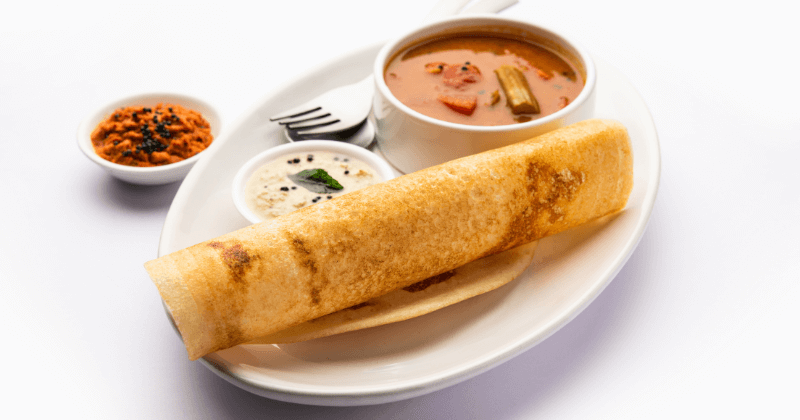How Much Protein is in Dosa?
Dosa, the beloved South Indian delicacy, is a staple in Indian households and a favorite at breakfast tables across the country.
Crispy, golden, and delicious, dosa is not just a treat for the taste buds but also a nutritious food item.
While many people consume dosa for its taste, those who are health-conscious often wonder: How much protein is in dosa?
Protein is a vital nutrient for muscle building, tissue repair, and overall body function. If you are someone who tracks your daily protein intake, it is essential to know how much protein your dosa provides.
In this blog post, we will explore the protein content of dosa, its variations, and how you can make it even healthier!
How Much Protein is in Dosa?
A standard plain dosa is made from fermented rice and urad dal (black gram) batter.
A plain dosa contains about 3-4 grams of protein per 100 grams, while variations like moong dal or egg dosa can have 7-12 grams per serving.
Here’s the approximate protein content:
-
1 Medium-Sized Plain Dosa (50-60g): 2-3 grams of protein
-
Large Dosa (80-100g): 3-4 grams of protein
Why Is Protein Content Low?
Since dosa batter consists mostly of rice (a carbohydrate source), the protein comes mainly from urad dal.
Fermentation improves protein digestibility but doesn’t drastically increase the amount.
Nutritional Breakdown (Per Medium Dosa):
-
Calories: 120-150 kcal
-
Carbs: 20-25g
-
Protein: 2-3g
-
Fat: 3-5g (mostly from oil/ghee used for cooking)
While dosa isn’t a high-protein food, pairing it with protein-rich sides can boost its nutritional value.
Protein in Different Dosa Varieties
Not all dosas are created equal! Here’s how protein content varies across popular types:
| Dosa Type | Protein (per dosa) | Key Ingredients |
|---|---|---|
| Plain Dosa | 2-3g | Rice + Urad Dal |
| Masala Dosa | 5-6g | Potato filling adds minimal protein |
| Rava Dosa | 3-4g | Semolina (sooji) + curd |
| Pesarattu (Moong Dal Dosa) | 6-8g | Green gram (high-protein) |
| Oats Dosa | 4-5g | Oats + dal batter |
| Besan Chilla (not dosa, but similar) | 8-10g | Chickpea flour |
Winner? Pesarattu (Moong Dal Dosa) packs the most protein!
How to Increase Protein in Dosa?
Want to make your dosa more protein-rich? Try these easy tweaks:
Change the Batter Ratio
-
Use more urad dal (increase from 1:3 to 1:2 dal-to-rice ratio).
-
Replace some rice with quinoa or millet (bajra, ragi).
Add Protein-Rich Fillings
-
Paneer stuffing (cottage cheese)
-
Sprouted moong/methi filling
-
Soya chunks or tofu bhurji
High-Protein Side Dishes
-
Sambar (with lentils) – adds 4-5g protein per bowl
-
Coconut chutney with roasted chana dal – 3g protein per serving
-
Greek yogurt or curd – 6-8g protein per 100g
Protein Powder Dosa (Yes, It Works!)
Add 1 scoop of unflavored whey or plant-based protein to the batter. This can add 10-15g protein per dosa!
Dosa vs. Other Indian Breakfasts: Protein Comparison
How does dosa stack up against other popular breakfasts?
| Food | Protein (per serving) | Carbs (g) | Calories |
|---|---|---|---|
| Dosa (plain) | 2-3g | 20-25g | 120-150 |
| Idli (2 pieces) | 4-5g | 15-20g | 100-120 |
| Poha | 3-4g | 30-35g | 150-200 |
| Upma | 5-6g | 25-30g | 180-220 |
| Besan Chilla | 8-10g | 10-15g | 150-180 |
| Egg Omelette (2 eggs) | 12-14g | 1-2g | 140-160 |
Verdict:
-
For protein, besan chilla or eggs win.
-
Dosa is lighter but lower in protein unless modified.
Is Dosa a Good Post-Workout Meal?
After a workout, your body needs protein + carbs for recovery.
Pros of Dosa Post-Workout
✔ Easy to digest (fermented batter)
✔ Provides quick energy (carbs from rice)
✔ Can be customized for protein (add fillings/sides)
Cons
❌ Low protein unless enhanced
❌ High glycemic index (plain dosa spikes blood sugar)
Expert Tips for a High-Protein Dosa Diet
- Ferment Longer for Better Protein Absorption - Fermentation breaks down anti-nutrients, making the protein more bioavailable.
- Try Multigrain Dosa - Mix ragi, bajra, or jowar flour for extra protein & fiber.
- Pair with a Protein Shake - If eating 2-3 dosas, balance with a protein smoothie (banana + peanut butter + whey).
- Use Non-Stick Pan to Reduce Oil - More oil = more fat, which isn’t ideal for a protein-focused meal.
- Meal Prep Protein Dosa Batter - Prepare moong dal or quinoa dosa batter in bulk for quick, healthy meals.
Conclusion
Dosa is a delicious and nutritious meal, but its protein content varies depending on the ingredients used.
While traditional dosa has a moderate amount of protein, opting for high-protein variations like moong dal dosa, ragi dosa, or egg dosa can help you get more protein from this beloved dish.
If you are on a high-protein diet or looking to build muscle, dosa can be part of your meal plan, but you should supplement it with other protein-rich foods.
